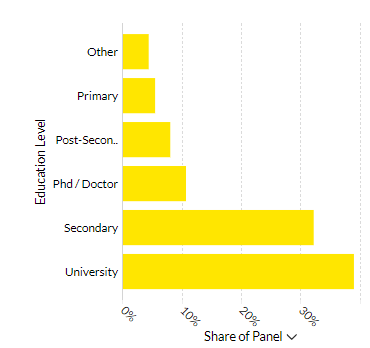Probability Panels are not perfect and nor is Lifepanel. In this article we will be looking at some of the demographic skews that occur within probability panels at the different stage from recruitment to survey data collection. Next to that we share some of the approaches we have used at Lifepanel to improve our panel demographics.
TL;DR:
- Online Probability Panels are not perfect but come with their on sets of skews and limitations
- Due to the online nature aspects like education, age, gender can be skewed as part of the recruitment process.
- Within online probability panels it is possible to account for these skews using weighting.
1. What are probability panels
Online probability panels like Lifepanel are a valuable tool in market research. These panels consist of a group of individuals who have been carefully selected to represent the target population. The selection process ensures that each panel member has a known and non-zero probability of being chosen to participate in surveys and studies. This method provides researchers with a more accurate representation of the general population, allowing for more reliable data and insights. Online probability panels are often used to gather information on consumer preferences, opinions, and behaviours, making them an essential resource for businesses and organisations seeking to make informed decisions.
2.Importance of accurate representation of demographics in probability panels
The accurate representation of demographics in probability panels is of utmost importance for several reasons. Firstly, it ensures that the sample used for research or surveys is representative of the population being studied. This is crucial as it allows for the generalisation of findings to the larger population. Without accurate representation, the results may be biassed and not reflect the true characteristics and behaviours of the population.
Secondly, accurate representation of demographics helps in identifying disparities and inequalities within different groups. By including diverse demographics in probability panels like Lifepanel, researchers can analyse the data to understand if certain groups are being underrepresented or marginalised. This information is vital for policymakers and organisations to address social issues and implement targeted interventions.
Furthermore, accurate representation of demographics in probability panels promotes inclusivity and fairness. It ensures that all individuals have an equal chance of being selected for research or surveys, regardless of their background or characteristics. This helps to eliminate biases and prejudices that may arise from excluding certain groups from participation.
Lastly, accurate representation of demographics in probability panels enhances the validity and reliability of research findings. When a sample is representative of the population, the results can be confidently generalised. This increases the credibility of the research and allows for more accurate decision-making based on the findings.
Probability-based panels like Lifepanel allow respondents to take a finite amount of interviews per month, in the case of Lifepanel the maximum survey is just one per month. This allows respondents to have a higher attention during the survey as survey fatigue is reduced significantly, ultimately yielding higher quality data even with lower sample sizes.
3,Understanding Panel Demographics and the Impact of Errors
Panel demographics, such as age, gender, education, occupation, urbanicity, and income, are crucial factors in survey research. They provide valuable insights into the characteristics of a population and help researchers draw meaningful conclusions. However, when conducting surveys using probability panels, several errors can impact these demographics. Two significant sources of error are coverage error and non-response error. Additionally, internet access limitations can further complicate the accuracy of panel demographics (coverage error).
Skews due to coverage errors
Coverage error refers to the discrepancy between the target population and the actual population covered by the survey. It occurs when certain segments of the population are not included or are underrepresented in the panel. This error can have a significant impact on panel demographics. For example, if a survey is conducted using online panels, individuals without internet access will be excluded from the sample. This exclusion can lead to biassed results, especially if those without internet access differ systematically from those with access.
For the case of Lifepanel, coverage error can occur due to part of the population not having access to a phone or not having internet access.
Skews due to non-response
Non-response error occurs when selected individuals choose not to participate in the survey or fail to respond to survey requests. Within probability panels, the first part of recruitment for the panel before an actual survey comes with non-response error as well.
Non-response error in probability panels:
- Not responding to the recruitment survey.
- Not completing the profile for demographics and accepting the privacy policy.
- Non completing a survey upon invitation within the panel.
Within probability-panels the overall response is usually lower compared to an ad-hoc CATI or F2F survey as it includes the non-recruits, non-profiled and the non completes of a survey.
This error can also affect panel demographics. For instance, if younger individuals are more likely to ignore or decline survey invitations, it may result in an overrepresentation of older age groups in the panel. Similarly, if certain occupations or education levels are less likely to respond, it can lead to a skewed representation of these demographics.
4.The impact of skews within the panel on data quality
In this section the consequences of demographic skews and ways to address them are discussed.
Consequences of demographic skews in probability panels
Inaccurate representation of population characteristics
Panels overall while designed to be representative, can suffer from selection bias where certain segments of the population are underrepresented or overrepresented. For example, younger individuals, ethnic minorities, or lower-income groups might be less likely to participate in such panels due to access issues or lack of interest. It is therefore crucial for researchers to acknowledge these limitations and work towards improving recruitment strategies and panel diversity to ensure more accurate and inclusive data collection. At Lifepanel we therefore screen for secondary languages and browser language to also include part of the population that is not fluent in the native language.
Biassed estimates and conclusions and Reduced generalizability
As a result, the findings derived from these panels may not truly reflect the diverse opinions, behaviours, and experiences of the entire population. This skew can lead to erroneous conclusions and misguided policy decisions that do not adequately address the needs of all societal groups. The collected data can then not be generalised for the entire population.
Importance of addressing demographic skews for data quality improvement
Both coverage error and non-response error can have a compounding effect on panel demographics. If certain demographic groups are more likely to experience coverage error or non-response error, their representation in the panel may be significantly distorted. This distortion can limit the generalizability of survey findings and compromise the accuracy of conclusions drawn from the data.
Internet access limitations further exacerbate these issues. While online panels offer convenience and cost-effectiveness, they inherently exclude individuals without internet access or with limited digital literacy. This exclusion can disproportionately affect certain demographic groups, such as older adults or individuals from low-income backgrounds who may have limited access to technology. Consequently, panel demographics may not accurately reflect the broader population, leading to biassed results and potentially misleading conclusions.
In conclusion, panel demographics play a vital role in survey research, providing valuable insights into the characteristics of a population. However, errors such as coverage error and non-response error can distort these demographics in probability panels. Internet access limitations further compound these issues. To ensure accurate and representative results, researchers must be aware of these challenges and employ appropriate strategies to mitigate biases and improve the quality of panel demographics.
Differences in Demographics due to Recruitment-Bias: The case of Sweden
Figure 1: Recruitment Skews for Lifepanel Sweden
5.Demographics that can be skewed in probability panels and the reasons for that
Panel demographics such as age, income, gender, education, occupation, and rural/urban level are impacted by non-response error and non-coverage error in the following ways: – Non-response error occurs when individuals selected for the panel do not participate or provide incomplete responses. This can lead to a biassed representation of panel demographics.
Education demographics
Education demographics may be biassed if individuals with certain educational backgrounds are more likely to decline participation or provide incomplete responses. In the case of Lifepanel, lower education segments are underrepresented. The reasons for that could be twofold: The first one being that lower educated people are less likely to respond to surveys which can be seen in CATI surveys as well, secondly that respondents over-state their education level.
Occupation demographics
– Occupation demographics can be impacted by non-response error if individuals in specific occupations are less willing to participate or fail to provide complete occupational information.
Rural/Urban level demographics
Rural/urban level demographics may be affected if individuals from rural or urban areas are more likely to refuse participation or not fully disclose their location. Coverage levels for internet penetration, telephone or SIM card ownership might differ among rural and urban areas. In Western Europe this should be less likely of an issue.
Age Demographics
Age demographics can be affected by non-coverage error if certain age groups are underrepresented in the panel due to sampling limitations. Regarding probability panels like Lifepanel, this might be due to response pattern (eg. response rates among 18-29 seems to be lower compared to other age groups). On the other hand, enrolment into a panel requires some basic technical knowledge which might not be available for the highest age bands among all members. Lifepanel in these cases tries to ensure that the enrolment process is as smooth as possible. Also using SMS and WhatsApp as additional pre-notification and reminder ensures higher response rates among the younger age segment due to multiple attempts.
Income Demographics
Income demographics may be biassed if individuals with higher or lower incomes are less likely to be included in the panel sample.
Gender Demographics
Gender demographics can be influenced by non-coverage error if certain gender groups are underrepresented in the panel due to sampling limitations.
6. Mitigation strategies Lifepanel uses due to ensure maximum coverage and reduction of demographic biases?
To mitigate these issues, researchers must employ various strategies. First, efforts should be made to ensure a diverse and representative sample by using multiple recruitment methods and oversampling underrepresented groups. Secondly, researchers should employ weighting techniques to adjust for coverage and non-response biases. These techniques aim to make the panel demographics align more closely with the target population. Additionally, researchers should explore alternative modes of data collection, such as telephone or mail surveys, to reach individuals without internet access.
Sampling techniques to reduce coverage skew
Several sampling techniques can be applied to mitigate the coverage skews in probability panels.
Oversampling underrepresented groups
Oversampling underrepresented groups is a critical sampling technique employed to mitigate coverage skews in probability panels. By intentionally increasing the proportion of certain segments of the population that might otherwise be underrepresented due to smaller sizes or lower response rates, researchers can ensure that these groups’ opinions and behaviours are accurately reflected in survey results. This technique not only enhances the representativeness of the sample but also allows for more precise subgroup analyses. Without oversampling, there’s a risk that the insights derived from a study may be biassed, failing to capture the true diversity and nuances of the broader population. Underrepresented groups in probability panels can be segments with lower education level as overall recruitment and completion rate is lower for these but as well as younger panel members. In the case of Lifepanel, the need to oversample younger panel members is not necessary as the interaction of SMS and WhatsApp yields higher recruitment and completion rates for these compared to generic CATI interviewing.
Utilising auxiliary data for adjustment
By incorporating auxiliary information, such as demographic and geographic data from census records or administrative databases, researchers can adjust their weighting schemes to better reflect the overall population. This process, known as post-stratification, involves aligning the sample distribution with known population margins across various strata. Additionally, techniques like propensity score matching can be used to adjust for differences between the panel and the target population based on observed characteristics. This ensures that the final survey results are more accurate and reduces the bias introduced by uneven coverage, leading to more reliable and generalizable findings. For Lifepanel, all data can be delivered in unweighted or weighted format. It needs to be considered that weighting increases the Design Effect and subsequently leads to a smaller net effective sample size.
Strategies to minimise non-response skew
Implementing effective panel recruitment design and administration techniques
In order to minimise overall non-response skew in probability panels, it is important to look at the recruitment part of the panel, the competition part and lastly the completion rate. Each of these different elements require different ways to reduce the overall non-response rate. First, employing stratified sampling methods ensures the panel is representative of the population, with several follow-up messages to increase recruitment rate and thus lower recruitment bias for the panel. Second, multiple recruitment channels should be used, which in the case of Lifepanel consists of phone numbers that are recruited via landline CATI, Mobile CATI, SMS and Whatsapp to ensure different population segments get recruited. . Third, the initial recruitment should be followed by effective panel maintenance strategies such as regular communication, engagement activities, and incentives tailored to the panelists’ preferences and motivations. Fourth, providing a user-friendly interface for survey completion can reduce barriers to participation. Fifth, monitoring response rates closely and conducting follow-ups with non-respondents through personalised reminders or alternative contact methods can help address potential biases early on. Additionally at Lifepanel panel members are engaged by receiving feedback on the collected surveys and links to news articles. Lastly an attractive incentive system with clear monetary incentives or donations rather than a credit system is used.
Utilising weighting techniques to adjust for non-response bias
When certain segments of the population are less likely to respond to surveys, the results can become unrepresentative of the overall population. To correct this, researchers apply weights to the responses based on the inverse probability of a person responding. This means that if a particular group is underrepresented among respondents, each response from that group will count more in the final analysis. By doing so, the weighted data more accurately reflects the demographics and opinions of the entire target population. This process, known as post-stratification weighting, involves aligning survey samples with known population characteristics such as age, gender, and education level. When done correctly, weighting can significantly reduce the non-response bias, leading to more reliable and valid survey results. At Lifepanel the option is provided to deliver the datasets in weighted and non-weighted data.
7. Conclusion
Recap of demographic skews in probability panels due to coverage and non-response
Demographic skews in probability panels are due to the various non-response patterns as part of the recruitment, profiling and surveying of the target population. On top of that there are challenges with keeping a probability panel engaged.
Importance of addressing these skews for accurate and reliable research findings
When deciding on how to sample your target audience it is important to look at the various sampling challenges and ask how a panel provider addresses these skews. Asking overall on panel demographics from recruitment, ways of recruitment and how the panel is managed can help to reduce the impact on the collected data. At Lifepanel, full transparency is provided when it comes to demographics at the recruitment stage, how the sampling frame is composed but also what is the completion rate. Going a step further it is possible for researchers to get access of the demographics of the non-completes to account for that using post-stratification methods.





